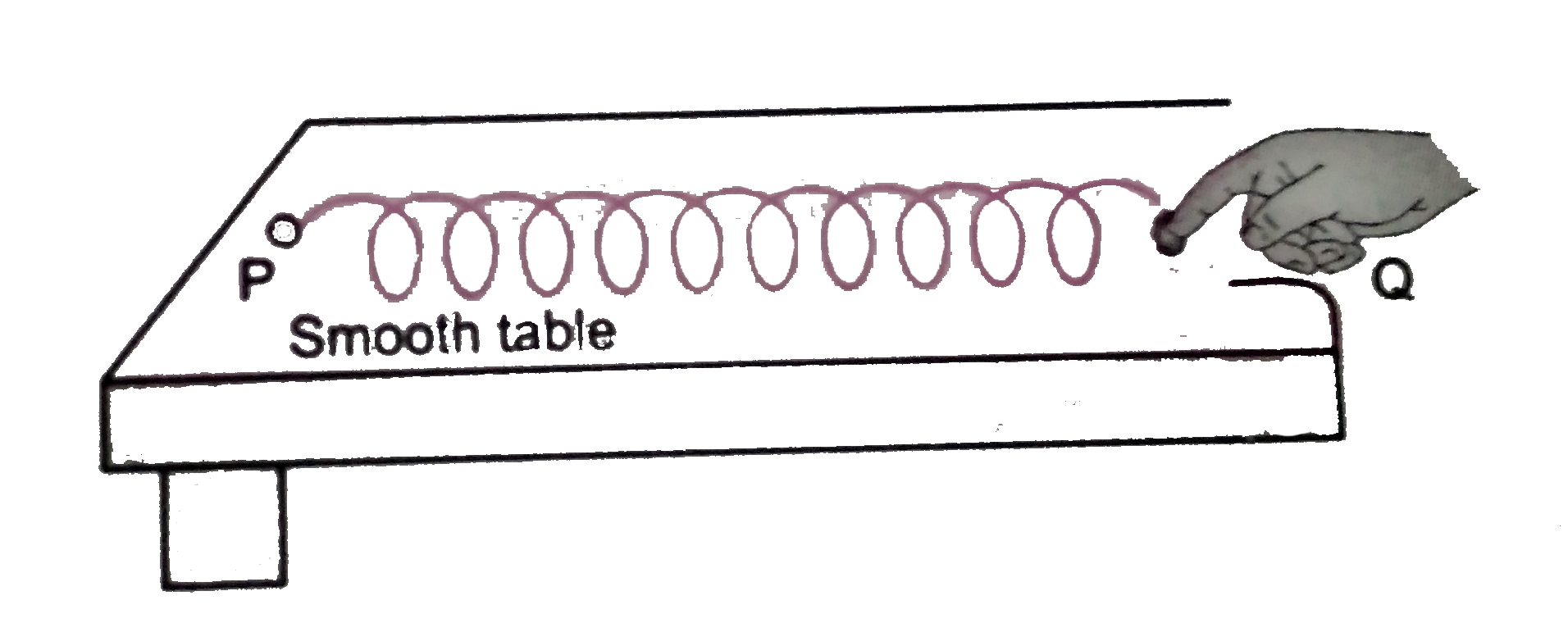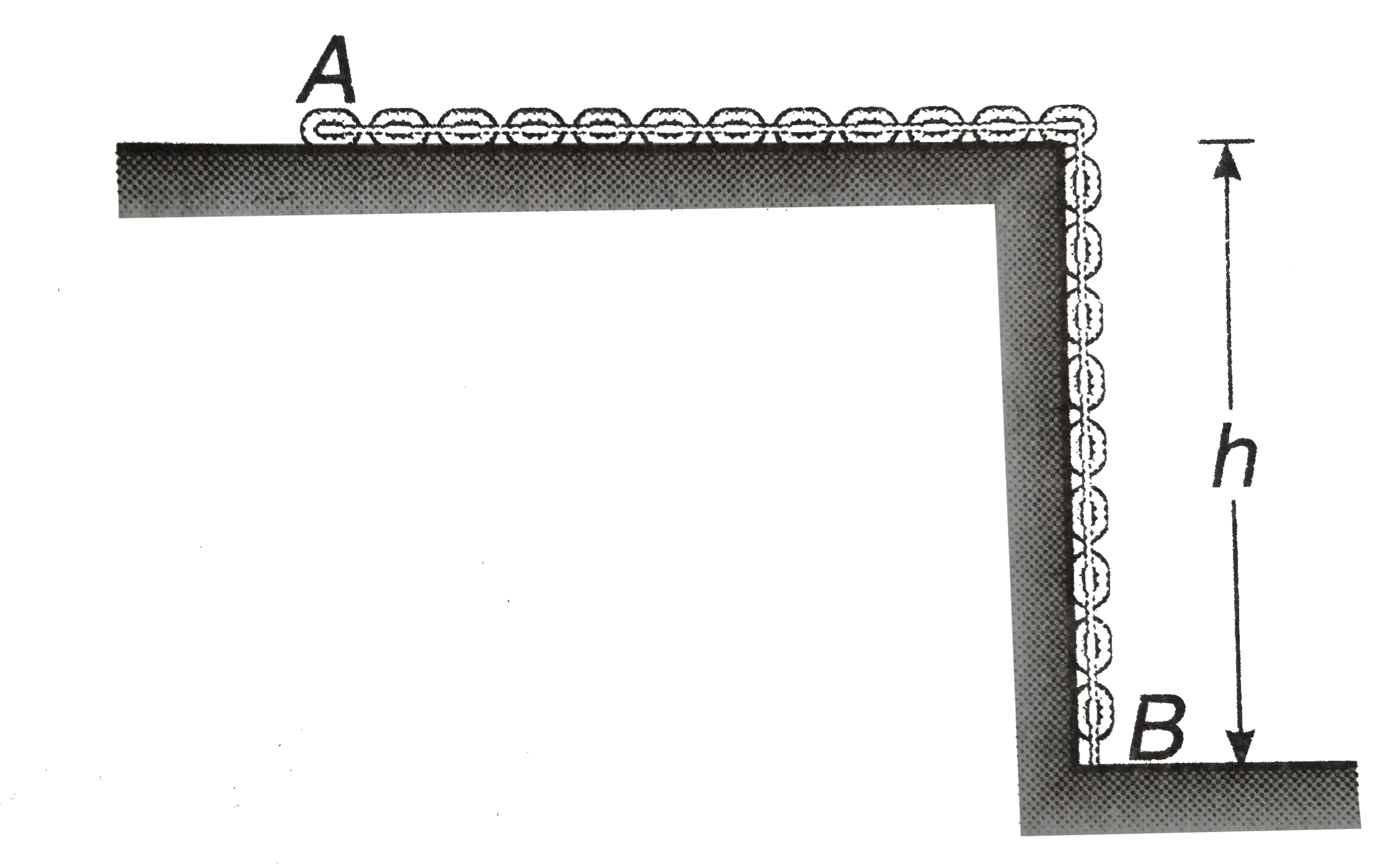A student sets up a slinky PQ on a smooth table top in the manner
How can he produce transverse waves in the slinky by moving its free end Q ?
 .
.
At an angle of 45∘ with the table top
Backward and forward along the length of the slinky
Up and down
Left and right
The correct Answer is:D
In transverse wave, vibration of a wave is perpendicular to its direction of propagation of wave.
Topper's Solved these Questions
- BOOK - SCIENCE OLYMPIAD FOUNDATION CHAPTER - SOUND EXERCISE - Achievers Section (HOTS)5videos
SOUND
- BOOK - SCIENCE OLYMPIAD FOUNDATION CHAPTER - SOME NATURAL PHENOMENAEXERCISE - ACHIEVERS SECTION (HOTS)4videos
SOME NATURAL PHENOMENA
- BOOK - SCIENCE OLYMPIAD FOUNDATION CHAPTER - STARS AND THE SOLAR SYSTEM EXERCISE - ACHIEVERS SECTION (HOTS)5videos
STARS AND THE SOLAR SYSTEM
Similar Questions
The water level in a vertical glass tube 1.00 m long can be adjusted to any position in the tube. A tuning fork vibrating at 900 Hz is held just over the open top end of the tube, to set up a standing wave of sound in the air-filled top portion of the tube. (That airfilled top portion acts as a tube with one end closed and the other end open.) (a) For how many different positions of the water level will sound from the fork set up resonance in the tube's air-filled portion? What are the (b) least and (c ) second least water heights in the tube for resonance to occur?
View SolutionA chain (AB) of length l loaded in a smooth horizontal table so that its fraction of length h hangs freely and toucher the surface of the table with its end B. At a certain moment ,the end A of the chain is set free. With what velocity will this end the chain slip out of the table ?
 .View Solution
.View Solution
Knowledge Check
- Question 1 - Select One
A student sets uo a slinky PQ on a smooth table top in the manner
How can he produce transverse waves in the slinky by moving its free end Q ?
 .Aat an angle of 45∘ with the table topBbackward and forward along the length of the slinkyCup and downDleft and right.
.Aat an angle of 45∘ with the table topBbackward and forward along the length of the slinkyCup and downDleft and right. - Question 2 - Select One
A string has a linear mass density μ. The ends of the string are joined to form a closed loop and is given the shape of a circular ring of radius R. this ring is now rotated about its axis with an angular velocity ω
Q. The velocity of the transverse wave set up in the string, with respect to an observer at the centre ofAωRB2ωRC3ωRD4ωR - Question 3 - Select One
A string has a linear mass density μ. The ends of the string are joined to form a closed loop and is given the shape of a circular ring of radius R. this ring is now rotated about its axis with an angular velocity ω
Q. The velocity of a transverse wave set up in the string, with respect to the string isAωRB2ωRC3ωRD4ωR
When a particle is restricted to move along x-axis between x=0 and x=a, where α if of nenometer dimension, its energy can take only certain specific values. The allowed energies of the particle moving in such a restricted region, correspond to the formation of standing waves with nodes at its ends x=0 and x=a. The wavelength of this standing wave is related to the linear momentum p of the particle according to the de Broglie relation. The energy of the particle of mass m is related to its linear momentum as E=p22m. Thus the energy of the particle can be denoted by a quantum number n taking values 1,2,3, ...(n=1, called the ground state) corresponding to the number of loops in the standing wave.
Use the model described above to answer the following three questions for a particle moving along the line from x=0 to x=α. Take h=6.6×10−34Js and e=1.6×10−19C
Q. The speed of the particle that can take discrete values is proportional toView SolutionWhen a particle is restricted to move along x-axis between x=0 and x=a, where α if of nenometer dimension, its energy can take only certain specific values. The allowed energies of the particle moving in such a restricted region, correspond to the formation of standing waves with nodes at its ends x=0 and x=a. The wavelength of this standing wave is related to the linear momentum p of the particle according to the de Broglie relation. The energy of the particle of mass m is related to its linear momentum as E=p22m. Thus the energy of the particle can be denoted by a quantum number n taking values 1,2,3, ...(n=1, called the ground state) corresponding to the number of loops in the standing wave.
Use the model described above to answer the following three questions for a particle moving along the line from x=0 to x=α. Take h=6.6×10−34Js and e=1.6×10−19 C.
Q. If the mass of the particle is m=1.0×10−30kg and α=6.6nm, the energy of the particle in its ground state is closest toView SolutionWhen a particle is restricted to move along x-axis between x=0 and x=a, where α if of nenometer dimension, its energy can take only certain specific values. The allowed energies of the particle moving in such a restricted region, correspond to the formation of standing waves with nodes at its ends x=0 and x=a. The wavelength of this standing wave is related to the linear momentum p of the particle according to the de Broglie relation. The energy of the particle of mass m is related to its linear momentum as E=p22m. Thus the energy of the particle can be denoted by a quantum number n taking values 1,2,3, ...(n=1, called the ground state) corresponding to the number of loops in the standing wave.
Use the model described above to answer the following three questions for a particle moving along the line from x=0 to x=α. Take h=6.6×10−34Js and e=1.6×10−19 C.
Q. The allowed energy for the particle for a particular value of n is proportional toView SolutionA stretched slinky is given a sharp push along its length. A wave travels from one end to another. The wave so produced is
View SolutionThere are five boggarts placed in a maze on blocks A,B,C,D and E. Every student starts on Block X, and can control the movement of other blocks. The objective is to take their wands from the centre of the maze and use it to shoot the boggarts
As the maze is enchanted, there are restrictions on the movement of the blocks. Each block can be made to travel horizontally or vertically, but only directly towards another block -- as far as it can go until hitting it edge to edge. One set of move is a continuous sequence of such movements made by the same block. Each move is indicated by the block’s letter followed by the directions traveled: up (U), Down (D), left (L), and right (R). For Example, X- RUL is one move, which states that Block X first moved Right, then Up, then Left. How many times does each of the blocks,student move? (A, B, C, D, E, X) and total set of moves?
 View Solution
View Solution

